Is it ESSENTIAL to rug a horse? Yes/no/maybe?
Jan 25, 2021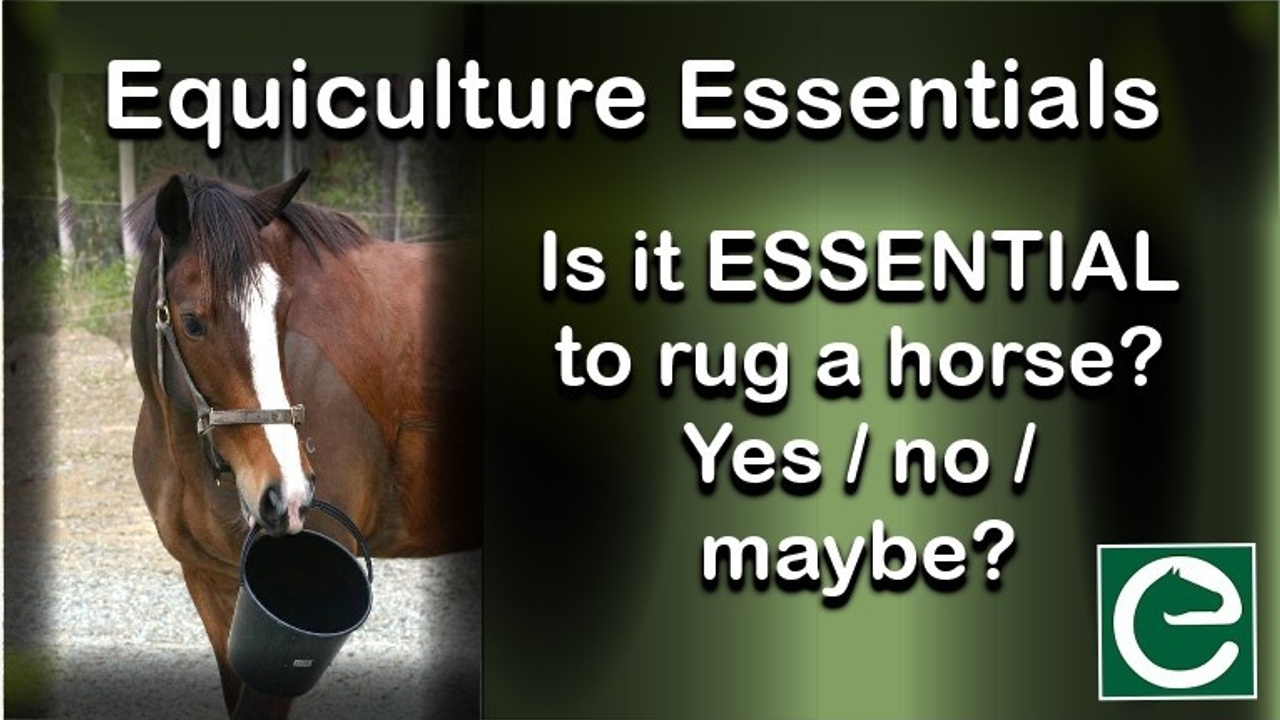
The short answer is NO, but just like everything in life, there are exceptions!
MOST horses do not need to be rugged
A young to middle-aged, fit, healthy horse should not need to be rugged to keep warm. However, a horse should always have access to shelter. So, a thin-skinned horse fastened in a field/paddock for hours with no access to a shelter will get too cold/wet if there is prolonged inclement weather.
The same horse will usually be fine if they can get themselves out of the bad weather. A horse should preferably be able to take themselves to a surfaced area with shelter (man-made or otherwise). This way, they do not have to stand around in mud. This is what we (EQUICULTURE) advocate with THE EQUICENTRAL SYSTEM.
Other horses that need to be LIGHTLY rugged are horses that are allergic to insect bites (called ‘Sweet Itch’ in the UK and USA and ‘Queensland Itch’ in Australia). Such horses should also be able to get to shade. A fan fitted in the shade can work well to disperse the insects.

Some horses are allergic to insect bites and need to be rugged for protection.
While it is true that wild and free-living horses survive without rugs, they move more than their domestic counterparts and can find their own shelter from bad weather. They also do not tend to live as long as domestic horses. Older domestic horses may therefore need extra warmth in cold, wet weather.
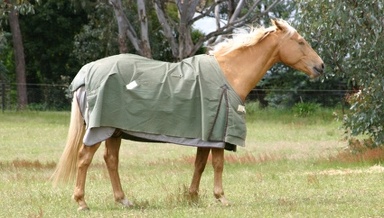
Older horses may need to be rugged to maintain weight.
Some breeds of horses have very fine skin and a fine coat (such as Thoroughbreds, Standardbreds and Arabs). This means they feel the wet and cold more than tougher, hardier breeds of horse/pony. There are always exceptions though, so treat each horse as an individual.
Should horses wear rugs in summer?
Rugging a horse in warm weather/summer can be a WELFARE ISSUE. Rugs DO NOT keep a horse cool. A horse naturally has a sleek coat reflecting the sun and will seek shade when they are hot as a natural response to being too warm.
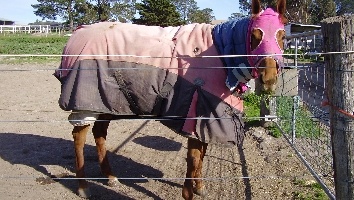
Rugging a horse in warm/hot weather can be a welfare issue!
Important points to keep in mind when rugging horses are:
-
Large-bodied animals, such as horses, take LONGER TO COOL DOWN (and longer to warm up) than smaller-bodied animals (this is one of the reasons very small dogs, for example, shiver easily in cool conditions – they get cold quickly).
-
Rugs PREVENT any cooling breeze from cooling the body. Also, horses are one of the few animals that rely on SWEATING to cool down. Rugs IMPEDE this process (by preventing air from passing over the body, evaporating the sweat and cooling the body).
Some people rug a horse in summer to prevent their coat from fading in the sun. THIS IS NOT A GOOD ENOUGH REASON TO RUG IN SUMMER. If a horse has access to shade, they will utilise it in the heat of the day. If coat fading is an issue for you, confine your horse to a cool shady area through the day (in hot weather), with access to hay, and turn them out at night. This can be particularly beneficial for a horse with white skin over areas such as the nostrils and the ears and therefore gets sunburned easily. It will also reduce the problem of insects for the horse because insects are not as problematic in the shade and at night.
Should horses be rugged in winter?
In cold, wet weather, a good quality and well-fitting rug CAN HELP a horse to maintain condition, as a cold wet horse will burn a lot of energy keeping warm.
Remember, if your horse is young and healthy but tends to get fat, rugs will help them to STAY FAT. In the natural situation, excess body fat is burned off through the winter, and the horse starts lean in the spring (this is a good thing). This means they can cope with the new grass much better than an already fat horse.
You may not have heard this information before, but it is essential if you want to manage your horse well. Horses ARE MEANT to reduce their weight in the winter to cope with the abundance of better grasses in the spring. One of the reasons that domestic horses are so prone to Laminitis is that they are usually kept fat over winter, and they come into spring already fat. Then they get even fatter on the spring grasses and are at a much higher risk for Laminitis. Rugging adds to this problem by reducing the amount of energy they use to keep warm.
The coat of an unrugged horse stands up in cold weather to trap air and warm them. A rug prevents this from happening. In some circumstances, a rugged horse is COLDER than an unrugged horse because a thin rug will flatten the hair coat without providing warmth. If the rug does not fit well, the horse will move less (or not at all) and be colder.
Should a clipped horse be rugged?
If you clip your horse in the winter so that you can keep exercising them, you will most likely need to rug. The exception is if you have a horse that you are trying to reduce their weight, and you only clip the lower half of the body (a low trace clip), and the horse has access to shelter; in this case, you should be able to get away with not rugging, and the horse will lose weight. The horse may be muddy and wet when you want to ride. Good pasture management goes a long way to vastly reducing mud in the winter (sign up for this free mini-course called Horses, Pasture and Grazing.
Keep in mind that horse rugs can create more work for you
A rugged horse needs to be checked regularly (at least twice a day) to ensure that the straps have not broken and the rug has not slipped, which can cause injury.
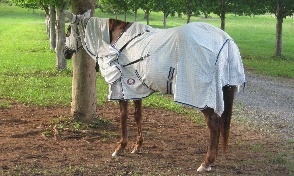
Hoods can slip and cause serious injuries.
Hoods can be very dangerous for horses and should only be used if the horse is being checked very frequently (much more than twice a day) because if a hood slips, it can cover the eyes and rub the eyeball (which can cause an ulcer in the eye – a severe condition for a horse requiring immediate veterinary attention). Horses with slipped hoods (due to inability to see) have been known to fall into waterways (and drown), injure their eyes on branches or other protrusions or panic and run through fences.
A rug should be removed regularly to ensure it is not rubbing, letting in water etc. and to monitor the horse’s weight.
Rugs prevent horses from exfoliating their skin properly (by rolling and mutual grooming etc.), so a rugged horse must be groomed frequently and thoroughly to get rid of the build-up of dead skin and hair.
Horse rugs do change their behaviour
This is an important point that people often do not think about. Rugs PREVENT horses from form carrying out mutual grooming behaviour. This is a critical behaviour for horses. They spend a lot of time carrying out this behaviour daily. Unfortunately, rugs prevent this normal behaviour from taking place.
Common injuries caused by horse rugs
Rugs can and do cause injuries to a horse. Common injuries caused by rugs include:
- Pressure sores BEHIND the withers. This can be due to the rug being too large in the neck, which results in the rug sitting behind the withers. Every time the horse lowers their head, it pulls the rug into the withers. Eventually, the horse will stop grazing.
- Pressure sores ON the withers. Some high-withered horses become sore from the sheer weight of the rugs.
- Pressure sores at the BASE OF THE NECK, where the neck joins the chest. When this happens, the horse will be very reluctant to move. If they do move, they may move in ‘fairy steps’. You should be able to run your hand from the chest, up and over the withers, without feeling tight.
- SORES on the inside of the thigh due to the rug slipping over to one side and the leg strap pulling up into the groin. Or when the legs straps are fitted too tight. Correctly fitted leg straps should cross through each other. The point where they meet should be roughly between the hocks and where the buttocks meet.
- A horse can GET CAUGHT UP in fences and injure themselves by becoming hooked on a wire fence via their leg strap fasteners. Always clip them in toward the horse, as this reduces the chance of this happening.
- If any fasteners BREAK, the rug will usually slip, and a horse can panic with a rug that is half on and half off. Panicking horses can injure themselves as they attempt to escape the rug.
- If a rug is LETTING IN WATER, a horse can develop rain scald and other skin problems.
How to fit a horse rug
If you do decide to use a rug, it must fit well. Think of how you feel when wearing an article of clothing that does not fit, rides up or is too tight. How quickly do you want to get it off? This is how a horse feels with an ill-fitting rug that it has to wear all day, every day.
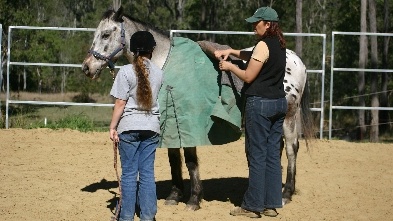
A rug should always fit well.
So should you rug a horse?
Avoid using rugs UNLESS YOU HAVE TO. Your horse may not look as smart or clean as you would like, but it is natural for a horse to be muddy/dusty. Make sure you do not rug just because other people think you should. Think carefully before you rug an already fat horse. Do not rug if you cannot check the horse very frequently. If you do rug, ensure it fits well and is of good quality.
If you enjoyed this article, check out the others on the blog. Also, make sure you sign up for the free mini-course called Horses, Pasture and Grazing and the free 23-page PDF called 10 common POSITION and BALANCE checks for riders

















